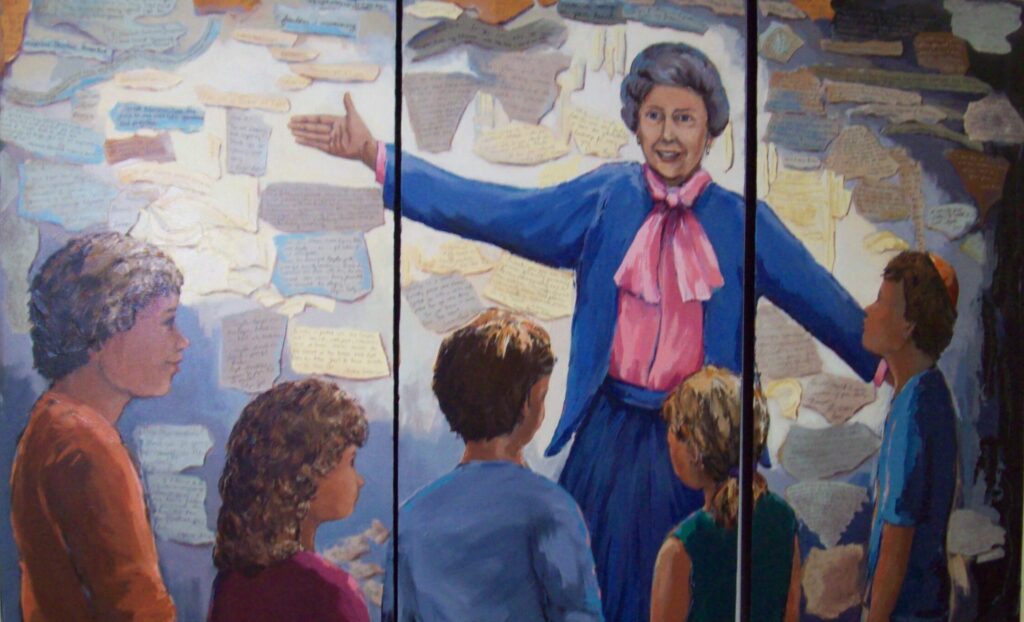
Michael Messer’s project, Propaganda and Appropriation: The Use of Symbolism by Anti-Semitic Publications and its Use and Effect on Jewish Victims, draws on forgotten histories through once forbidden arts. With this work, Messer vividly brings to life the stories of Jewish Holocaust survivors Walter Ziffer and his mother, Eric Wellisch, Susan Cernyak-Spatz, and Eva Abraham-Podietz.
The project features two original pieces of artwork, each accompanied by a comprehensive guide. Through his work, Messer highlights how Jewish imagery was used both as a symbol of identity and pride and as a tool in anti-Semitic propaganda.
By intertwining art and history, Messer not only addresses the Holocaust and oppression but also tells the survivors’ stories through a profound study of Jewish symbolism, its misuse in propaganda, and its reclamation. His project is a testament to resilience, memory, and the enduring power of art.
Der Ewige Jude

Michael Messer’s first piece, titled ‘Der Ewige Jude,’ is named after a notorious art exhibit and film. The ‘Der Ewige Jude’ exhibition, held in Munich from November 1937 to January 1938, depicted exaggerated and grotesque Jewish stereotypes. It portrayed Jews with large ears, drooping noses, and swollen lips, caricaturing figures like Charlie Chaplin and Leon Trotsky.
The accompanying film, directed by Fritz Hippler, reinforced these dehumanizing images, likening Jews to parasites and vermin. This propaganda aimed to incite fear and hatred, suggesting Jews were threats to society, embodying both capitalist and socialist extremes.
These stereotypes were even taught to children through books like ‘Der Giftpilz,’ which described how to identify Jews by their physical traits. This toxic imagery became the face of anti-Semitism, portraying Jews as cunning exploiters of the German people.
Messer’s artwork reflects on these historical distortions, confronting the harmful legacy of propaganda and honoring the resilience of those who endured its impact.
When You See This Symbol

Michael Messer’s second piece, titled ‘When You See This Symbol,’ is a collection of hand-drawn Jewish-identifying patches from WWII, personalized with the stories of Holocaust survivors. These patches, recommended by Nazi SS General Reinhard Heydrich in 1941, featured a yellow Star of David around the word ‘Jew’ in the native language of each area, intended to mark and shame Jews.
Despite this, some Jews personalized their patches, transforming a symbol of oppression into one of identity and pride. For instance, Walter Ziffer, in his testimony, shows an embroidered armband, marveling at its beauty. Similarly, survivor Eric Wellisch proudly wears a hat with a ‘J,’ embracing his Jewish identity.
Messer’s artwork captures these personalizations, showcasing patches from different countries and the unique stories behind them. Walter Ziffer’s green star includes his number and initial. Eric Wellisch’s star is red and black with a ‘J,’ representing his hat. Susan Cernyak-Spatz’s purple star features her number, a symbol of her identity. Eva Abraham-Podietz’s gold star with a raised fist symbolizes her fight and pride in being Jewish.
Through this collection, Messer highlights the resilience and defiance of Jewish survivors, turning a symbol of persecution into one of strength and individuality.
